How to Celebrate New Year’s and Christmas in Peru: A Traveler’s Guide


What comes to mind when you think of Christmas? Snow-dusted trees, cozy fireside chats, and Santa decked out in his winter best? Well, forget all that. In Peru, the festive season looks more like sipping cocktails on a sun-soaked beach or watching fireworks light up the night sky while the Andes loom in the distance.
At the end of December, Peru flips the holiday script. Picture temperatures hitting a balmy 30 °C (high 80s °F), palm trees swaying instead of pine trees, and traditions that blend Catholicism with centuries-old Andean culture. If you're thinking about spending Christmas in Peru, you can be sure that Peru offers a holiday experience you won’t find anywhere else.
From bustling markets in Cusco to midnight feasts under fireworks in Lima, Peruvians celebrate Christmas (Noche Buena) and New Year’s with flair, fireworks, and a little bit of quirk. If the idea of eating 12 grapes at midnight or running down the street with an empty suitcase has you intrigued, then you’re in for a treat. Learn more about Peru.

Cusco
Ready to trade in ugly sweaters for sandals? This guide has you covered, with tips on where to go, what to do, and how to embrace the festive spirit like a local. Get ready to rethink your holiday traditions—Peru-style!

My top tips for celebrating Christmas in Peru
- Learn festive phrases like "Feliz Navidad" and "Feliz Año Nuevo" to connect with locals and spread cheer wherever you go.
- Celebrate Noche Buena on December 24th with a traditional midnight feast featuring marinated turkey, pasta salad, and rice. Don't miss the fireworks at midnight!
- Visit Santurantikuy market in Cusco for unique, handmade Christmas decorations and Andean artisan gifts on December 23rd and 24th.
- Indulge in Peruvian Panetón and hot chocolate—a sweet Peruvian twist to kick off Christmas Day.
- Pack for summer weather, but prepare for variety: Peru is diverse! Bring lightweight clothing for coastal heat and a jacket for cool evenings in Cusco. And don’t forget your sunscreen—nothing says "gringo in Peru" like a Christmas sunburn!
- Try the 12 grapes tradition on New Year’s Eve—make a wish with each grape when the clock strikes midnight.
- Prepare for vibrant parties in Cusco’s Plaza de Armas on New Year’s Eve, or head to Lima's beaches for a tropical celebration.
- Dive into local New Year’s traditions, like walking the streets with a suitcase to guarantee a year full of travel.
- Book everything in advance, from hotels to train tickets for Machu Picchu. Peruvians travel a lot during the holidays, and spots fill up fast.
Sometimes, all you need to do is take the first step... I've filtered out the best hotels in Peru for you
Save it for yourself to come back to later, or share with your friends on social media!
I've already planned your ititnerary for the trip, complete with my travel tips.
My favorite hotels in Peru:
- Cusco: Hilton Garden Inn
- Lima: Hilton Lima Miraflores
(Disclaimer: I’m not flat out pushing Hilton hotels, it’s just that in Peru, it’s way better value to stay at international hotel chains than at local places, and these two Hiltons happen to be the best accommodations I stayed at in these cities.)

Be prepared for heat, cold, rain, sun, fog, wind—anything is possible during Christmas in Peru
Christmas traditions in Peru: What to expect and how travelers can join in
Christmas is very important in Peru because the majority of the population is Christian. As a result, there are so many fascinating traditions.
To begin, Peruvians observe Christmas from the evening of December 24th until midnight. They call it Noche Buena (=Good Night). On December 25, the city appears empty and quiet. Start partying on the 24th if you want to feel like a true local.
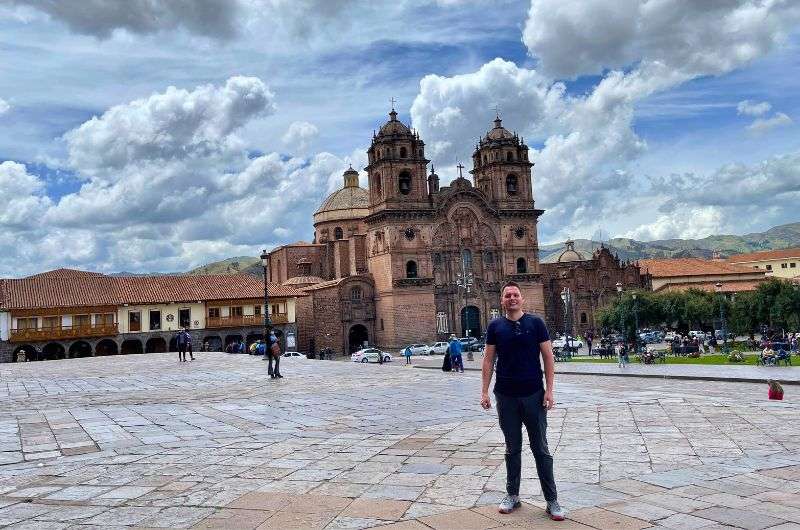
Experiencing Noche Buena in Cusco was marvelous!
December 24th: How Peruvians celebrate Christmas Eve
Christmas in Peru is celebrated in a family circle, as it is in most other countries.
Christmas trees are common in Peru, especially in urban areas like Lima, Cusco, and Arequipa. While they’re not a traditional part of Peruvian culture, the influence of global Christmas customs has made them popular.
You’ll find artificial trees decorated in homes, plazas, malls, and even in smaller towns. In some places, these trees are adorned with local touches like Andean ornaments.
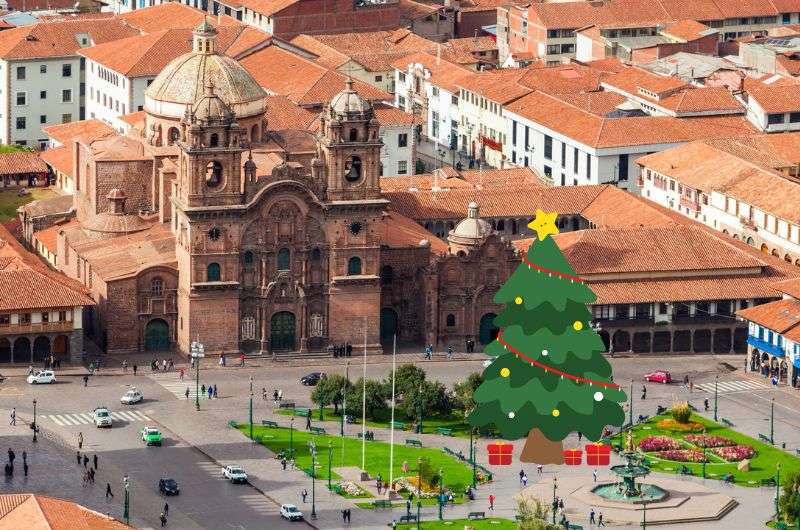
I spent the end of the year in Cusco and somehow managed to get zero photos that scream Christmas in Peru
Peruvian Christmas food: Christmas dinner
Peruvians prepare turkey using a traditional recipe and serve it with rice; others prefer pasta salad and applesauce. Preparing this Christmas dish is akin to a ritual.
The turkey is first marinated in traditional spices such as aj panca. Then it is baked for several hours, under the watchful eyes of the cooks, and brought to the right temp.
The dishes on the Christmas table are largely determined by family customs. And, yes, they also have turkey for their 12 am dinner (or is it better to call it breakfast?).
- Travel tip: If you’re staying in Peru during the holidays, check with local restaurants to see if they’re serving traditional Noche Buena feasts—many will offer special menus for tourists. Book early, or you’ll be stuck with sad leftovers.
Fireworks and presents
At midnight, the city is filled with loud fireworks. It's a wonderful sight, especially if you're in a decorated area with a panoramic view.

Who doesn’t love fireworks?
After the fireworks, the sleepy children go to bed and the parents pretend to be Papá Noel (Peruvian Santa) and put presents under the tree. By the way, it is not customary to buy Christmas gifts for adults in Peru, usually they’re only given to children.
December 25th: Christmas Day in Peru
It is customary in Peru to have a Christmas cake known as Panetón (dried fruit cake) for breakfast or dessert. The recipe was inspired by Italian culture and slightly adapted. In Peru people usually have Panetón with a traditional Peruvian hot chocolate.
You might think it's kind of weird to drink hot chocolate when it's summer outside, but Peruvians would argue with you. They believe that the combination of Panetón and hot chocolate creates a Christmas atmosphere like none other.
Peruvians even have special gatherings (Chocolatadas) at Christmas, where they eat Panetón and drink hot chocolate.
Peruvians usually spend morning of December 25th calmly and finish up the leftovers from the holiday table.
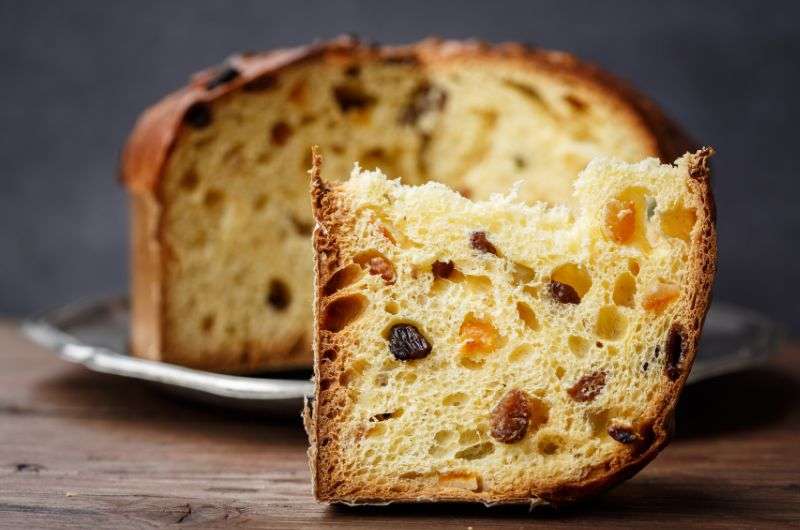
Panetón
Christmas traditions in Peru’s top destinations
Christmas Eve in Peru, or Noche Buena, is when the real magic happens. From fireworks lighting up the skies to markets buzzing with last-minute shoppers, each destination offers its own unique take on the festivities.
Christmas in Lima: Traditions, events, and festive cheer
Spending Christmas in Lima is a mix of heartfelt tradition and city hustle. The streets sparkle with lights, and Parque de la Reserva’s Magic Water Circuit goes full-on festive with a holiday light show that’s basically a slightly classier fireworks display.
On December 24th, families celebrate Noche Buena with a midnight feast of roasted turkey, tamales, and panetón paired with hot chocolate. Yes, hot chocolate. Because what better way to embrace summer heat than with a steaming cup of cocoa?
At midnight, fireworks burst over the city, and churches like the Lima Cathedral in Plaza Mayor welcome everyone for Misa de Gallo. Spoiler alert: The “rooster” mass has no actual roosters.

The many faces of Lima\
Christmas markets in Miraflores and Barranco sell everything from handcrafted gifts to random ornaments that may or may not survive the trip home. Meanwhile, chocolatadas pop up around the city, where locals share hot chocolate and panetón with those in need—a tradition that warms your heart even if the chocolate makes you sweat.
- Travel tip: Book hotels and Christmas Eve dinners early unless you enjoy “festive” last-minute scrambling. Also, factor in Lima’s traffic—it’s like Santa’s sleigh in reverse: lots of stops and zero magic.

Cusco: where Andean and Christian traditions meet
Cusco is a unique place to spend your Christmas holiday in. That’s because of its festive atmosphere, as well as the mix of Andean and Christian traditions.
Every year on December 23rd and 24th the main square of the city (Plaza de Armas) is filled with stalls. In the square you can buy a variety of Christmas decorations, gifts, artisan goods and other interesting things. This event is called Santurantikuy.

Cusco Cathedral
Whether you want to buy something or not, I recommend visiting this place. At the very least you will have the opportunity to taste the local delicacies and get into the Christmas spirit. What would Christmas in Peru be without some strange foods you've never seen and probably can't pronounce?
- Travel tip: Santurantikuy is magical, but it’s also chaos, especially at night. Go in the morning for a calmer experience, and keep your valuables close—Santa’s not the only one with a bag of goodies this season.
During the whole month of December, you can see nativity scene installations in Cusco. Some of them can be entered and photographed. Sometimes the installations are huge, sometimes smaller.
They are all very different and made in an original way. In the main square you can find a life-size scene. Tourists love this location.

In Cusco, the main action happens in the main square
Churches are open to the public. They often display their own figurines of baby Jesus in his cradle.
- Travel tip: The nativity scenes in Cusco are next-level cool. Snap a pic with the life-sized one in Plaza de Armas, but don’t stop there—small villages often showcase unique Andean-style scenes. Think alpacas instead of sheep.
As expected, hotels will fill up fast for the holidays. To book the best ones, make your bookings way in advance. Take a look at my Cusco itinerary to see where the main tourist attractions are so you can find a hotel in a good location.
One that I can wholeheartedly recommend in Cusco is Hilton Garden Inn. It has fantastic views over the city from the (delicious!) restaurant, and they even do acclimatization massages!
Machu Picchu: Celebrate Christmas in the famous Inca city
Spending Christmas at Machu Picchu is as magical as it sounds. While the ancient citadel doesn’t exactly hang stockings or host carolers, there’s something undeniably special about visiting this iconic site during the holiday season.

Christmas on Machu Picchu? Absolutely yes!
Imagine wandering through mist-covered ruins on Christmas morning, surrounded by the grandeur of the Andes and the serenity that only Machu Picchu can offer. Consider hiring a guide at the entrance for a deeper appreciation of the site’s history and culture.
Christmas at Machu Picchu is about simplicity and connection—to nature, history, and the incredible engineering of the Inca civilization. The crowds are smaller compared to peak season, and the rainy-season greenery makes the site feel like a living postcard. Aguas Calientes, the town at the base, adds a festive touch with holiday lights and seasonal menus at local restaurants.
- Travel tip: Pack for rain—December is the rainy season, but a little afternoon shower won’t ruin the experience if you’re ready for it.
What to know before you go to Machu Picchu for Christmas
- Open on Christmas: Machu Picchu is open every day of the year, including Christmas.
- Tickets: Book your entry tickets at least 2 months in advance on the official website (machupicchu.gob.pe) and select your time slot carefully (or just grab what’s left!).
- Getting there: Travel independently by driving to Ollantaytambo, then taking a train to Aguas Calientes, and finally a short bus ride to Machu Picchu.

Book your entry tickets in advance!
- Travel tip: Whatever you decide, make sure to learn how to get to Machu Picchu first so you are aware of all the logistics of getting there and securing the right tickets. Peruvians enjoy traveling within their country, especially during holidays, so tickets sell out fast.
Another way to make your holidays in Peru memorable could be to stay in a glass pod attached to a mountain side at the Vertical Sky Luxury Suites. They are located near Ollantaytambo, which you will inevitably be passing through on your way to and from Machu Picchu.
How to spend Christmas in Peru as a tourist?
Peru has many things to offer. The scope of activities is really diverse and depends on your preferences. You’ll most likely start your trip in Lima.
For those who want to have an exotic Christmas celebration, here’s your chance to spend the holiday on the beach. With traditional Peruvian drinks the celebration’s going to be very fun.

You can also choose to celebrate Christmas in Peru on the beach
There’s also an option of visiting the real jungle, like from Iquitos (another town not served by a road)! You’ll definitely remember a Christmas at one of the jungle lodges in the area.
If you lean towards more traditional destinations in Peru, you can choose Cusco or perhaps hang out in Puno by Lake Titicaca.
There are many things to do during the Christmas holidays in Peru. But what about New Year’s? How’s it celebrated? Is it worth visiting during this time?
New Year’s Eve in Peru: the best places and traditions for travelers
New Year's Eve is probably the biggest party in Peru. By this time, young Peruvians have spent a fair amount of time with their families and are ready to hang out in the streets.
Сusco gets crazy on the night of December 31st to January 1st. All the clubs, bars, pubs and cafes are open! On this day, they often hold special events. On New Year's Eve, clubs earn huge fees, because people just don't want to sit at home.

Plaza de Armas in Cusco
Peruvians love to walk around Plaza de Armas. Many of them even set off fireworks from early evening to morning. There are also a lot of beach-inspired parties in the city.
- Travel tip: If Cusco’s on your New Year’s agenda, ditch the heels. Cobblestones and cocktails don’t mix well with them. Also, get your hotel reservations locked down ASAP.
Peruvian New Year’s traditions travelers should try
The 12 grapes tradition
The first cool tradition I would like to share with you is the 12 grapes tradition. When the clock strikes twelve (a.m.), you have to eat 12 grapes and make a wish for each of them. It is believed that this is a magical time and wishes are sure to come true.
Bathing in flowers
Another interesting tradition is to take a floral bath (baño de florecimiento). Peruvians believe that the presence of each flower symbolizes something positive: the flower mix will bring not only the pleasure of the process, but also love, prosperity and happiness in life.

You can take a floral bath as a way of observance of Peruvian Christmas traditions
During December, special flower mixes are on sale in stores, so if you're an aroma bath enthusiast, it's worth a try. A similar Peruvian tradition involves lighting candles of different colors on New Year's Eve, as each has a different meaning.
Take a walk with your suitcase after midnight
In the first minutes of the new year, you can see many people with suitcases on the streets of Peru's cities. What kind of craziness is this and where is everyone going, I thought.
But it turns out that this ritual is also a New Year's tradition. It is believed that if you go out in the street with an empty suitcase in the first minutes of the year, the coming year will be filled with interesting travels.
Three potatoes

Weird tradition. But why not?
There is another funny tradition in Peru. It involves taking three potatoes and putting them under a chair. One should be completely peeled, one is partially peeled, and one is left with the skin. Then, without looking, you take one potato out.
If you take out a potato with skin—CONGRATULATIONS, the upcoming year will bring a lot of money!
- Travel tip: When you are in Peru for New Year’s, you can say to the locals ¡Feliz Año Nuevo! which means Happy New Year.
Dressing up for New Year’s in Peru
The choice of clothing on New Year's Eve also has special significance for Peruvians. For example, the color of clothing is important. People in Peru believe that:
- red will bring love
- yellow will attract good luck
- white will ensure health
- and green will make you rich in the upcoming year.
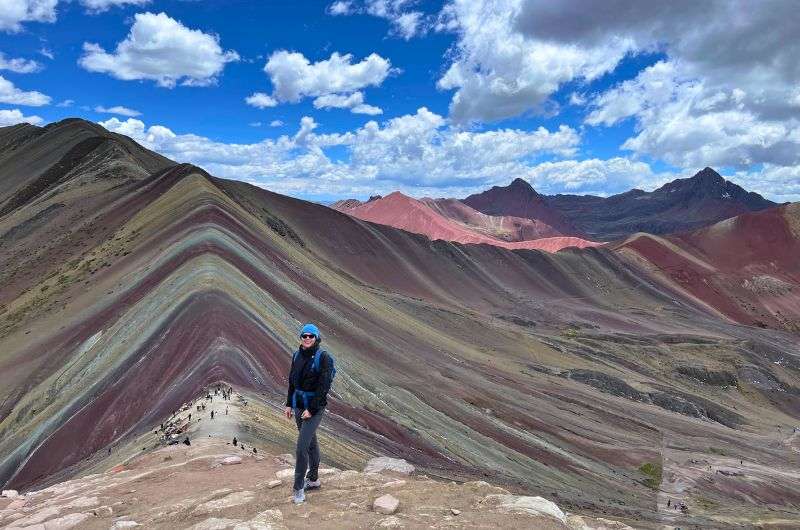
If you decide to go to Rainbow Mountain for New Year’s, you’ll get all the colors, so you’ll be covered for the next year!
Peruvians enjoy wearing new clothes on the celebration day as well. They represent openness to new experiences. This ritual is also associated with various costumes and the burning of dolls on New Year's Eve. All of this represents the transition from the old to the new.
Where to spend New Year’s Eve in Peru?
So, where is the best place to enjoy New Year’s celebrations in Peru?
New Year’s on Lima’s beaches
Peru has many beautiful places by the water. The most popular beaches are located in the south of Lima, for example Punta Hermosa, Asia, Punta Negra, Pulpos and El Silencio. These places are generally safe and definitely fun. Asia Beach is considered the most fashionable and fancy.

On the beach or in a pool is a good way to start your year
If you've already explored Lima and want to go somewhere else to celebrate, you might consider exploring Paracas. You’ll be partying with flamingos on the jaw-dropping coast, sipping pisco, and maybe even sandboarding!
Another option for celebrations outside of Lima is Máncora and Punta Sal. The beaches there are very beautiful, while the parties are really fancy and cool. They are about 1,200 km (745 miles) from Lima in northern Peru.
Spend New Year’s in Cusco
Basically, Cusco is the most party town in Peru and New Year's Eve is no exception. Go to the town center at Plaza de Armas, as the locals like to do. Here you can party in clubs, bars, and discos, as well as watch the fireworks.
The next day after the party is usually more relaxed. People need to regain their strength before the workday.
What happens on New Year’s Day in Peru?
After a fun night out, many Peruvians prefer to just stay home and rest. But for those who don't want to cook at home and still have the energy, there is the option to dine at a restaurant with traditional food.

Lechon
A typical dish for this day is lechon. This is roast pork, which is usually served with tamales (cornmeal flatbread with stuffing) and potatoes. It is a delicious dish, just try it!
Tip: I have a whole article on the food and drinks I like in Peru. Check it out to see what to see what to eat, what lama meat tastes like, and why not to expect good coffee in Peru. Surprising, right??
There are bowling-like games in the central square. They are called Sinkuy. Even the mayor and his wife take part in the games.
If you don't mind a little trip on January 1, you can visit magical Sacred Valley. Or, you can end up with an altitude sickness hangover just like I did after my Rainbow Mountain trip on the last day of the year.
Is Christmas a good time to visit Peru?
Yes, Christmas is an excellent time to visit Peru if you enjoy unique cultural experiences. The holiday season is filled with vibrant traditions like midnight feasts, fireworks, and festive markets. Coastal areas offer warm weather, while destinations like Cusco combine Andean and Christian customs. Just keep in mind that December is the rainy season in the Andes, so plan accordingly if you’re heading to Machu Picchu.
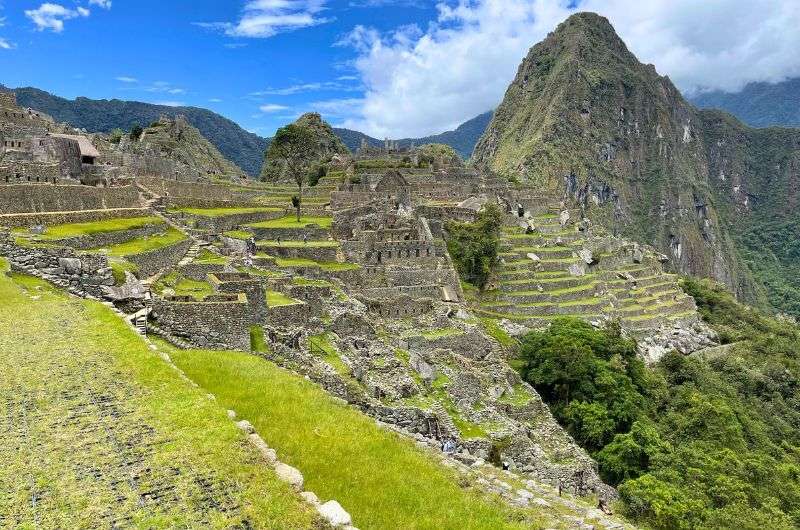
A trip to Machu Picchu in December can get very rainy, but the rain usually only comes in short bursts in the afternoons
What do people in Peru do for Christmas?
In Peru, Christmas is celebrated on December 24th with Noche Buena, a late-night family feast featuring turkey, tamales, and panetón (a sweet bread). At midnight, fireworks light up the skies, and gifts are exchanged, primarily for children. Many also attend midnight mass (Misa de Gallo) to honor the religious significance of the holiday.
Is December a good time to visit Lima, Peru?
Yes, December is a great time to visit Lima. The city’s coastal location means warm and sunny weather, ideal for exploring Miraflores and the historic center. Christmas brings festive decorations, pop-up markets, and a lively atmosphere. Just be prepared for increased crowds and book hotels early.

Lima is for those who like a lively Christmas and New Year’s
Is Machu Picchu closed on Christmas?
No, Machu Picchu is open on Christmas Day. The site operates every day of the year, including public holidays. Visitors can enjoy a unique holiday experience exploring this iconic destination. Just make sure to book your tickets and transportation well in advance, as availability is limited during the festive season.
Where is the best place to spend Christmas in Peru?
The best place to spend Christmas in Peru depends on your interests. Cusco offers a magical blend of Andean and Christian traditions, with highlights like the Santurantikuy market and midnight fireworks at Plaza de Armas. For warmer weather, Lima’s coastal districts like Miraflores provide festive lights and beach vibes. Nature lovers might enjoy celebrating near Machu Picchu or elsewhere in Sacred Valley for a serene and cultural experience.
Sometimes, all you need to do is take the first step... I've filtered out the best hotels in Peru for you
Save it for yourself to come back to later, or share with your friends on social media!
I've already planned your ititnerary for the trip, complete with my travel tips.
You might also be interested in reading:
- A 3–Day Cusco Itinerary
- A 2-Week Peru Itinerary: A Day-By-Day Trip Plan
- Top 14 Handpicked Luxury Hotels in Peru (With Prices)
- The 10 Best Ruins to Visit in Peru
- Top 9 Places to See in Sacred Valley
This post contains affiliate links. I earn a small commission if you make bookings through my links, at no additional cost to you. Thank you for your support!










Comments | Thoughts? Give us a shout!